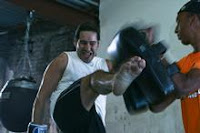The basic theory of bodybuilding is to build muscle by presenting them with ever increasing resistance while eating lots of proteins (so there will be raw material present in your body to build more muscle). Although this seems simple, when you get into it you quickly find that it is not so simple. The number of variables you are faced with actually makes training most effectively a complicated affair. On top of that, each person's body will respond slightly differently to the same training regime. And different bodybuilders have different goals.

So it is not always crystal clear what the best type and combination of training is to blast your muscles with. So what we are going to do here is talk about some of the basic ways you can add to the intensity of your workouts. Obviously factors like the number of reps and sets you do, the weights you use, the rest time between sets, rate at which you increase weight and so on are the fundamental controls we have to manipulate. But it might not be clear what to manipulate and why. Let's look at some of these "controls" to see how and why you would set them at certain values.
Ramp Up Weight
It is super important to keep increasing the weights you lift (or the resistance the muscles have to work against). The only way to build muscle is to damage and break them down so they grow back even bigger. To achieve this you have to constantly up the weight. If the weight does not progressively increase the muscles will get used to a certain level and stop being broken down, thus stop growing.
The best way to set your weight and make sure it keeps going up is to follow the progressive loading principle. It works like this. First you start with a light weight and do as many reps as you can. If you can do more than 12, the weight is too light. Keep increasing the weight until you can just barely do 12 reps. The last couple should really be blasting your muscles. Then over time as the 12 become easier, add more weight. Keep on adding weight so you are always just able to do 12 reps. Twelve is a good number, but it is not a rule. Most people using progressive loading use from 8 to 12 reps as the goal.
Number of Sets
You can up the intensity of your training by adding a couple more sets. The best number of sets is about 3 for more isolated muscles, like biceps for example and 5 for muscle groups, like thighs for example. You can bump sets up to 6 or 7 for an intensity boost. But such boosts should be for short time periods, say a month maximum. Also when adding more sets to your training, you should also add extra rest days for the muscle group you are giving the extra sets to.
Repetitions
You usually should do 8 to 12 reps for a set, according to the progressive loading principle we talked about above. But to increase the intensity of your training, you could drop the weight and add more reps. You can try a "two four" set : that is what I call it when you do 24 reps on a muscle. First you do 8 half motion reps working the muscle in one direction, then 8 half motions in the other direction and then 8 full reps to finish.
Speed
Normally the speed of a rep helps complete it. You can up the intensity by slowing the motion down. Move the weight as though you are doing a Matrix slow motion fight scene. You will find that this is really hard to do. It will certainly blast your muscles in a different way than before.
No Rest For the Wicked
Normally you should be taking about one to one and a half minutes of rest between sets. If your muscles are too tired you will not get maximum benefit out of a set. But to add to the intensity, you can lower this rest time. Be careful not to overdo it and keep an eye on the actual results you are getting. No point hurrying from set to set with little rest and not get any muscle growth due to excessive muscle tiredness. Try taking 25% off your normal rest time. For example, if you usually rest about a minute and a half between sets, that is 90 seconds. 25% of that is about 22 seconds. So cut your rest to 70 seconds or a minute and 10 seconds.
Negative Reps
It will often happen that on the return motion you still have something left after you have hit your maximum 12th rep on the forward motion. For example, if you are doing a bench press the 12th rep is your last lift. You just can't get the weight up for the thirteenth time. But you might still be able to manage the *downward* part of a 13th rep. What you can do is have a partner assist you to allow you to complete extra forward reps, then have the partner let you complete the reverse motion by yourself. This is a way of adding extra intensity where you might need it.
So here are a few things you can do to up the intensity of your training. But keep in mind that extra intensity should be used infrequently. Overdoing high intensity will just put you into overtraining and you will exhaust yourself and get little muscle growth. By all means throw on some extra intensity if you are feeling stale or if a while has gone by without seeing much progress in your muscle size.









































